Abstract
Introduction: The improper use of antibiotics to treat various bacterial infections occurring in humans had caused the rise of antibiotic-resistant bacterial strains. These lead to an urgent need in developing novel antimicrobial compounds. Objective: The extracts of the skin and seeds of Pisum sativum were screened for antimicrobial activity against two different species of Gram-positive bacteria (Staphylococcus aureus and Bacillus subtilis) and one species of Gram-negative bacteria (Escherichia coli). Materials and methods: Methanolic crude extracts were prepared at different concentrations. Their antimicrobial activities were screened by disc diffusion assays and minimum inhibitory concentration (MIC) determination assays. Results: Antimicrobial inhibitory effects were observed in B. subtilis. However, further investigation is needed to identify the reasons of S. aureus and E. coli being resistant towards both types of phytochemical extracts. Conclusions: Our findings support the hypothesis that the skin and seeds of P. sativum possess antimicrobial properties. Subsequent studies should be driven towards the identification of key phytocompounds, which can be potentially developed into new plant-based antimicrobial agents.
References
Khameneh, B., Iranshahy, M., Soheili, V. & Fazly Bazzaz, B. S. Review on plant antimicrobials: a mechanistic viewpoint. Antimicrob. Resist. Infect. Control 8, 118 (2019).
Ho, C.-Y., Lin, Y.-T., Labbe, R. G. & Shetty, K. Inhibition of Helicobacter Pylori by Phenolic Extracts of Sprouted Peas (pisum Sativum L.). J. Food Biochem. 30, 21–34 (2006).
Hadrich, F., Arbi, M. E., Boukhris, M., Sayadi, S. & Cherif, S. Valorization of the peel of pea: Pisum sativum by evaluation of its antioxidant and antimicrobial activities. J. Oleo Sci. 63, 1177–1183 (2014).
Saeed, S. & Tariq, P. Antibacterial activites of Mentha piperita, Pisum sativum and Momordica charantia. Pak. J. Bot. 37, 997–1001 (2005).
Nair, S. S., Madembil, N. C., Nair, P., Raman, S. & Veerabadrappa, S. B. Comparative analysis of the antibacterial activity of some phytolectins. Int. Curr. Pharm. J. 2, 18–22 (2013).
Patra, J. K., Das, G. & Shin, H.-S. Facile green biosynthesis of silver nanoparticles using Pisum sativum L. outer peel aqueous extract and its antidiabetic, cytotoxicity, antioxidant, and antibacterial activity. Int. J. Nanomedicine 14, 6679–6690 (2019).
Alarjani, K. M., Huessien, D., Rasheed, R. A. & Kalaiyarasi, M. Green synthesis of silver nanoparticles by Pisum sativum L. (pea) pod against multidrug resistant foodborne pathogens. J. King Saud Univ. - Sci. 34, 101897 (2022).
Castaldo, L. et al. Chemical Composition of Green Pea (Pisum sativum L.) Pods Extracts and Their Potential Exploitation as Ingredients in Nutraceutical Formulations. Antioxidants 11, 105 (2022).
Elsebaie, E. M. et al. Chitosan-Based Green Pea (Pisum sativum L.) Pod Extract Gel Film: Characterization and Application in Food Packaging. Gels 9, 77 (2023).
Abdelgani, A. M., Rukayadi, Y., Shaari, K. & Safinar, I. Antibacterial and Sporicidal Activities of Methanolic Sygygium polyanthum L. Leaf Extract against Vegetative Cells and Spores of Bacillus pumilus and Bacillus megaterium. J. Pure Appl. Microbiol. 12, 1047–1053 (2018).
Kusuma, S. A. F., Septyadi, R. & Sofian, F. F. Inhibition of bacillus spores germination by cinnamon bark, fingerroot, and moringa leaves extract. J. Adv. Pharm. Technol. Res. 13, 7–10 (2022).
R, S., S, R. & Dm, S. Serious infections caused by Bacillus species. Medicine (Baltimore) 66, (1987).
Gu, H.-J., Sun, Q.-L., Luo, J.-C., Zhang, J. & Sun, L. A First Study of the Virulence Potential of a Bacillus subtilis Isolate From Deep-Sea Hydrothermal Vent. Front. Cell. Infect. Microbiol. 9, 183 (2019).

This work is licensed under a Creative Commons Attribution-NonCommercial-NoDerivatives 4.0 International License.
Copyright (c) 2024 Asia Pacific Journal of Health Sciences and Research

